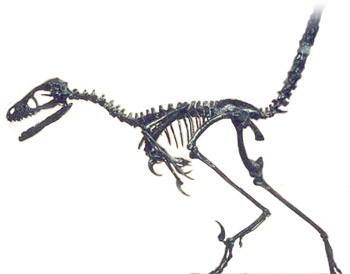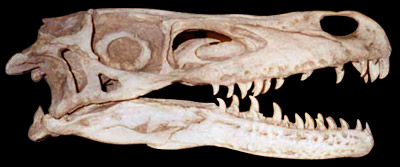Maniraptora (“Seizing Hands”)
Birds and their closest relatives
 Bambiraptor. Photo © Rob Gay. |
We all know now that birds are dinosaurs, right? The clade Maniraptora (which is defined as containing all dinosaurs closer to birds than to ornithomimids ) is the group of theropod dinosaurs that many paleontologists believe birds were derived from some 150 or so million years ago, in the Jurassic period. Hence, according to phylogenetic taxonomy, birds are by definition maniraptorans, and the other maniraptorans are their closest relatives.
The exact membership of this clade is highly disputed; any coelurosaur could be quite convincingly argued to be a member of Maniraptora. There is much convergent evolution apparent in Maniraptora, which makes the resolution of their phylogeny difficult; a problem compounded by their poor fossil record. Even without considering birds, Maniraptora is a diverse and interesting group, with many specimens that outwardly look
 Velociraptor skull. Photo © Rob Gay. |
We'll present some of the most accepted members of the clade Maniraptora; their position may very well change with future studies.
Major Maniraptoran groups:
Aves: The birds.
Dromaeosaurs: The "raptor" dinosaurs.
Troodontids: The smartest non-avian dinosaurs?
Therizinosaurs: Bizarre plant-eating theropods?
Oviraptors: Strange maniraptorans with evidence of devoted parental care.